#taiwan liberation day
Text
Update on Thailand's marriage equality bill:

Reporting by Panu Wongcha-um; Editing by Martin Petty
BANGKOK, March 27 (Reuters) - Thailand's lower house of parliament on Wednesday passed a marriage equality bill at the final reading, in a landmark step that moves the country closer to becoming the third territory in Asia to legalise same-sex unions.
The bill now requires approval from the Senate and endorsement from the king before it becomes law. It had the support of all of Thailand's major parties and was passed by 400 of the 415 lawmakers present, with 10 voting against it.
"We did this for all Thai people to reduce disparity in society and start creating equality," Danuphorn Punnakanta, chairman of the parliamentary committee on the draft bill, told lawmakers ahead of the reading.
"I want to invite you all to make history."
The passing of the bill marks a significant step towards cementing Thailand's position as one of Asia's most liberal societies on lesbian, gay, bisexual and transgender issues, with openness and free-wheeling attitudes coexisting with traditional, conservative Buddhist values.
Thailand has long been a draw for same-sex couples, with a vibrant LGBT social scene for locals and expatriates, and targeted campaigns to attract LGBT travellers.
The bill could take effect within 120 days of royal approval. Thailand would follow Taiwan and Nepal in becoming the first places in Asia to legalise same-sex unions.
The legislation has been more than a decade in the making, with delays due to political upheaval and disagreement on what approaches to take and what should be included in the bill.
The Constitutional Court had in 2020 ruled Thailand's current marriage law, which only recognises heterosexual couples, was constitutional, recommending legislation be expanded to ensure rights of other genders.
Parliament in December approved four different draft bills on same-sex marriage in the first reading and tasked a committee to consolidate those into a single draft.
(source)
94 notes
·
View notes
Text

NORAD head said Chinese aircraft may start operating near the US this year
Fernando Valduga By Fernando Valduga 13/03/2024 - 09:00 in Military
U.S. Air Force General Gregory M. Guillot, the new head of the North American Aerospace Defense Command (NORAD) and the U.S. Northern Command (NORTHCOM), warned lawmakers on March 12 that Chinese warplanes could start operating near the U.S. Air Defense Identification Zone (ADIZ) as early as this year.
“Fortunately, we have not yet seen Chinese aircraft operating near our air defense identification zones, but I think this will happen as early as this year,” Guillot told the House Armed Services Committee in his first testimony in Congress since he took office as NORAD and Commander of NORTHCOM in February. "This shows a general concern I have about China's growing capacity, not only with aircraft, but also with ships and even submarines capable of moving further away from China and getting closer to our coasts."
youtube
Air Defense Identification Zones are buffer regions that extend beyond territorial borders, covering airspace hundreds of kilometers from the coast that nations use to track approaching aircraft. NORAD tracks aircraft using a network of satellites, ground and air radars and combat aircraft, and all aircraft entering or leaving U.S. airspace from abroad must be identified in advance.
Russian fighters and bombers regularly enter the U.S. ADIZ, without entering U.S. or Canadian airspace. Occasionally, NORAD sends fighters to intercept these aircraft and escort them out of ADIZ. In February, NORAD reported three occurrences of Russian aircraft operating in the Alaskan ADIZ.
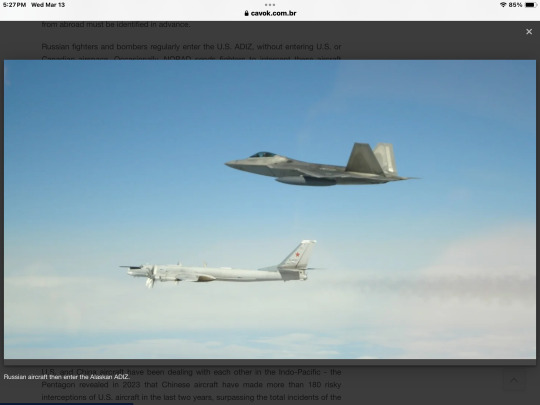
Russian aircraft then enter the Alaskan ADIZ.
The entry of Chinese aircraft into the US ADIZ, however, would mark an expansion of the reach of the People's Liberation Army. In recent years, the ELP has entered ADIZ around the island of Taiwan hundreds of times, sometimes sending dozens of planes in a single day, in movements that observers warn that they may be probing Taiwan's defenses or inducing them to a feeling of complacency.
U.S. and China aircraft have been dealing with each other in the Indo-Pacific - the Pentagon revealed in 2023 that Chinese aircraft have made more than 180 risky interceptions of U.S. aircraft in the last two years, surpassing the total incidents of the previous decade, increasing concerns about China's unpredictable and increasingly provocative behavior.
At the same time, Chinese surveillance balloons entered U.S. airspace five times in recent years, with the Pentagon losing several at the time they occurred, before one of them crossed the entire U.S. continental territory in January 2023, eventually being shot down after a few days.
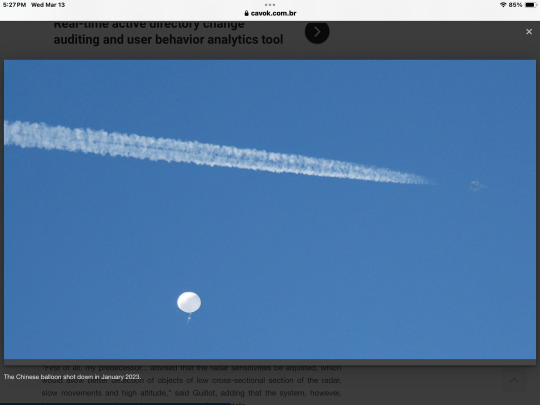
The Chinese balloon shot down in January 2023.
Guillot told lawmakers that NORAD has taken steps to better identify objects such as spy balloons that may have gone unnoticed in the past, filling the "domain knowledge gap" highlighted by his predecessor, General Glen D. VanHerck.
"First of all, my predecessor... advised that the radar sensitivities be adjusted, which would allow better detection of objects of low cross-sectional section of the radar, slow movements and high altitude," said Guillot, adding that the system, however, introduces some confusion due to the receipt of more data.
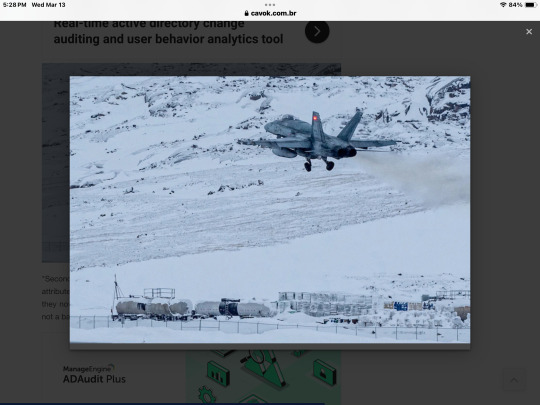
"Secondly, when our operators see intermittent hits that in the past would generally be attributed to the weather or other phenomena that would cause an inconsistent hit, they now continue to track them with more care and consistency to ensure that it is not a balloon or some other phenomenon," Guillot said.
"And the third is a better recognition of dominance among the other combatant commands. As we get the JADC2... the ability to share data from one combatant command to another, instead of stopping on a black line on a map that divides the regions, we can now share that information electronically in a transparent way to increase our consciousness even further away from our backs.”
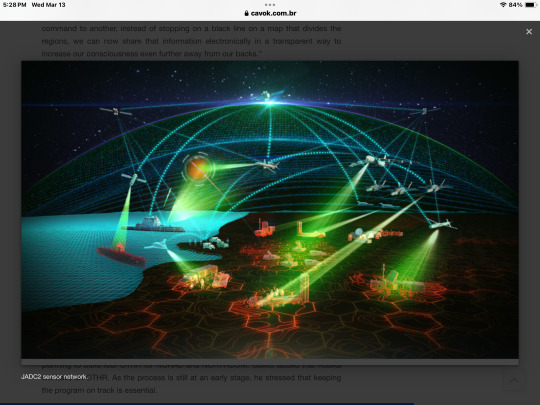
JADC2 sensor network.
Still, Guillot said that the surveillance systems of NORAD and NORTHCOM need more investments, calling radar beyond the horizon (OTHR) and the long-range discrimination radar (LRDR) as their "main priorities".
The Missile Defense Agency said in January that an LRDR missile defense system in Alaska is almost complete and will start operating at the end of this year. Both the U.S. and Canadian military have invested in the OTHR, with the U.S. Air Force planning to build four OTHR for NORAD and NORTHCOM. Guillot added that Alaska will have an OTHR. As the process is still at an early stage, he stressed that keeping the program on track is essential.
“This would give us capability against cruise missiles, traditional airstrips, as well as hypersonic weapons,” Guillot said. "Keeping this program on track is NORTHCOM's number one priority, due to the large capacity it would bring."
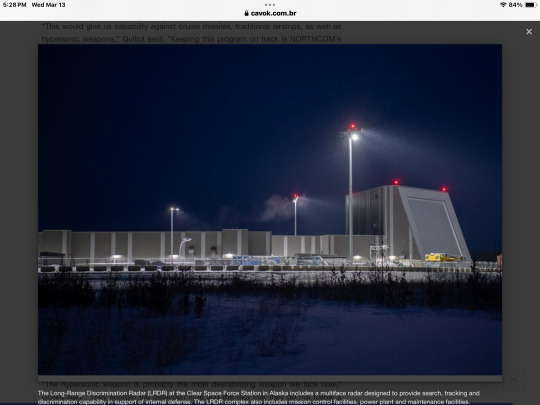
The Long-Range Discrimination Radar (LRDR) at the Clear Space Force Station in Alaska includes a multiface radar designed to provide search, tracking and discrimination capability in support of internal defense. The LRDR complex also includes mission control facilities, power plant and maintenance facilities.
Guillot added that hypersonic weapons pose a greater threat than intercontinental ballistic missiles (ICBMs) due to their ability to fly at lower altitudes and maneuverability.
“The hypersonic weapon is probably the most destabilizing weapon we face now,” Guillot said. "They shorten the detection time and the fact that they do not follow a traditional ballistic track means that they are very unpredictable and the area of uncertainty is huge, based on their speed and manoeuvrability. That's what makes them a challenge not only to detect, but also to track and eventually defeat."
Source: Air & Space Forces Magazine
Tags: Military AviationNORADPLAAF - China Air Force
Sharing
tweet
Fernando Valduga
Fernando Valduga
Aviation photographer and pilot since 1992, he has participated in several events and air operations, such as Cruzex, AirVenture, Dayton Airshow and FIDAE. He has works published in specialized aviation magazines in Brazil and abroad. He uses Canon equipment during his photographic work in the world of aviation.
Related news
MILITARY
Denmark prepares for delays in the delivery of F-35 fighters and seeks alternatives
13/03/2024 - 08:15
MILITARY
F-35 program reaches milestone C and full rate production
12/03/2024 - 23:37
HISTORY
Airbus C295 reaches 300 orders: learn interesting facts about this leading global aircraft
12/03/2024 - 22:47
MILITARY
IMAGES: RAF's Voyager refuelier operates with Swedish and North American fighters in Scandinavia
12/03/2024 - 18:07
AERONAUTICAL ACCIDENTS
India Air Force loses its first Tejas jet in an accident
12/03/2024 - 14:00
AERONAUTICAL ACCIDENTS
VIDEO: What we know so far about the accident with Russian Il-76 after engine fire in flight
12/03/2024 - 11:00
28 notes
·
View notes
Text
the chunk of pixiv that’s dedicated to drawing anime girls in military uniforms is becoming more and more like a balkan youtube comment section every day. everywhere you turn you have anime girls of competing ideologies, including but not limited to pro ukrainian, pro russian, People’s Liberation Army propaganda, operation paperclip (horny), whatever the fuck the south koreans are doing (unhinged), and you don’t even want to know what the catgirls think about the straight of taiwan
232 notes
·
View notes
Text
“I am opposed to war, unless in self-defense.” This was the most-liked comment on Douyin—the Chinese counterpart to TikTok—in reaction to a speech delivered by Chinese Foreign Minister Wang Yi on Jan. 9. In his address, Wang previewed China’s top diplomatic goals for 2024 and emphasized “the unwavering resolve of all 1.4 billion Chinese citizens to achieve reunification with Taiwan,” a statement made just days prior to the island’s general elections.
The broader reaction to Wang’s remarks likely wasn’t what the Chinese Communist Party (CCP) hoped for: Tens of thousands of Chinese social media users responded, many of them with grievances, sarcasm, and defiance, widely questioning the costs of a potential war.
One man from Shanghai complained, “Who is going to fight the war? If I die, who is going to pay my mortgage or my car loan?” Wang’s speech framed “national unification” as one of “China’s core interests,” but as one user from Hunan rebutted, “[China’s] core interests are that every Chinese can be treated equally and have access to elderly care and health care.” The pushback went beyond economic and social grievances. Some posters were even bolder, suggesting that Taiwan’s democracy may demonstrate a political alternative to mainland China: “The fact that Taiwanese choose their own way of life,” said one commentator from Shandong, “might show that Chinese people can take a different route.”
The mood among social media users is a sharp departure from past elections. After almost every Taiwanese general election since 2016, a wave of pro-war fever has swept the Chinese internet. After Taiwan’s 2020 elections, for example, upbeat war enthusiasts in China produced oil paintings that illustrated wild fantasies of the People’s Liberation Army (PLA) capturing Taiwanese President Tsai Ing-wen alive after landing in Taiwan and forcing her to sign an official surrender document onboard a Chinese aircraft carrier—a scene reminiscent of the 1945 Japanese surrender that ended World War II.
In 2021, one of the most popular songs to go viral on Chinese social media was “Take A Bullet Train to Taiwan in 2035.” Its allusion to a high-speed rail line connecting Beijing and Taipei was a dog whistle to nationalist masses who hoped that unification was on the horizon—by force, if necessary.
Absent from these fantasies, however, was the blood and violence that accompanies real war. At the time, China’s star was rising on the international stage, and public confidence was riding high on China’s success in controlling the COVID-19 pandemic within its borders. As such, the sentiments surrounding unification and the use of military force were quite romantic; many people believed that victory over Taiwan would be easy, that the Taiwanese would surrender voluntarily if the PLA simply blockaded the island.
In 2024, however, things have changed. The most recent Taiwanese presidential election—in which the pro-independence Democratic Progressive Party (DPP) won a repeat victory—served as an uncomfortable reminder to the Chinese public that neither Taiwanese politicians nor voters are interested in Beijing’s plans for political unification. Although the forceful unification narrative still exists, any push from nationalists to reignite war fever has now run into a wall of skepticism following the DPP victory.
“Wake up,” one Weibo user wrote in opposition to the broader online calls for forceful unification. “Stop dreaming,” another echoed. The defiant voices are becoming a common reaction to the suggested use of military force to an extent rarely seen, given the massive culture of censorship on Chinese social media.
A clear reason for this change is China’s economic slowdown. While Taiwan went to the polls in 2024, China was grappling with a youth unemployment rate above 20 percent, a housing market crisis with sales down by 45 percent, and a stock market in free fall that lost $6 trillion in just three years, the likes of which haven’t been seen in almost a decade. News about Taiwanese elections failed to arouse the same nationalistic reactions among the preoccupied Chinese public that had occurred in the previous two contests.
Instead, the 2024 elections triggered a flood of complaints: “Sort out our own economy, what a mess.” a Shanghai resident said angrily. “Look at our stock market,” an apparently frustrated investor from Hunan grieved, “It’d be better to keep the status quo, and leave Taiwanese alone.” The gloomy economy has made some commenters question the underlying justification for war: “With low-income people making less than 1,000 yuan a month ($140), and the national insurance tax going up, huge medical bills, and unaffordable apartments, why do you want forceful unification? I don’t get it.”
“It is the economy that really matters,” another person from Tianjin pointed out. “[Taiwan] being independent or not has nothing to do with ordinary people.”
The changing attitudes toward Taiwan’s elections reflect a broader shift in public sentiment in China’s online space. Discontent about the country’s poor economic reality has been growing louder, drowning out calls for a military takeover.
Ironically, the CCP’s own past propaganda efforts contributed to this cooling effect. Right before Nancy Pelosi, then the speaker of the U.S. House of Representatives, visited Taiwan in August 2022, official and semiofficial rhetoric in mainland China was so belligerent that it led many Chinese to believe that the day of unification had finally arrived and that the military would shoot down her plane and launch its attack on Taiwan imminently.
This was the peak of forceful unification hysteria, but it only left its crusaders disappointed. In the end, there was not only no shootdown of Pelosi’s plane, but there also weren’t even military exercises conducted before she left Taiwan. Many Chinese, especially forceful unification advocates, felt betrayed and disillusioned by their government’s failure to follow through on its belligerent rhetoric, and the after-effects of this letdown are still being felt today.
During Taiwan’s 2024 elections, war enthusiasts were continuously reminded of Beijing’s military inaction following Pelosi’s trip to Taiwan. “Have you guys forgotten Pelosi?” one said. One commonly repeated joke, observing the lack of military action, scoffed that the only thing that was fired up when Pelosi visited was the stove in her hotel. The kinds of threats that once resonated with nationalists now drew widespread ridicule online: “delusion,” “talking a big game,” “an unrealistic fantasy,” and “all hat, no cattle.”
Meanwhile, at the other end of the Chinese political spectrum, the 2024 election prompted the resurgence of the view among many liberals that Taiwan’s democracy represents a desirable political model. In the early 2010s, many Chinese saw Taiwan as a beacon of hope for Chinese society—a liberal, civic, and democratic alternative to the one-party state. The liberal Chinese writer Han Han coined a popular phrase—“The most beautiful scenery of Taiwan is its people.”—that encapsulated the view of how trustworthy and free a people can become under democracy.
But after the crackdown on liberal intellectuals and online speech under Chinese leader Xi Jinping, the honeymoon did not last long and was gradually replaced by a climate of xenophobia, jingoism, war euphoria, and a longing for unification by force. Making matters worse, a growing nationalist mood in Taiwan led many to believe that Taiwanese looked down on mainlanders.
The 2024 elections, however, prompted a renewed interest from the Chinese public about their neighbor, home to the world’s only Chinese-speaking democracy. News about Taiwanese elections aroused great curiosity on Weibo about the nuts and bolts of the electoral process—what a ballot looks like, how many ballots one can cast, how votes are counted, and how candidates are selected. When a few Taiwanese Weibo users answered these questions, they were liked and retweeted by thousands of Chinese accounts, drawing genuine admiration and blessings from many.
“Are we going to see one day like this?” one user from Gansu wondered with a crying emoji. “Maybe this is accumulating experience for our own future: giving speeches, holding debates, and counting votes,” commented another, from Tianjin.
China’s shifting public sentiment is bound to have repercussions for cross-strait relations, but it would probably be a bridge too far to infer that the Chinese public will fiercely oppose a war in the Taiwan Strait. Ultimately, the nationalist base remains. At present, the euphoria about forceful unification is quieting down, mainly because the party’s over-the-top propaganda failed to meet the expectations of its most ardent supporters. But if aggressive rhetoric were followed by military action in the future, war fever could be easily fanned again.
Despite the prevalence of extreme nationalism, Chinese public opinion is more divided on Taiwan than it seems, and these divisions are only likely to increase. What concerns most ordinary Chinese are decent jobs, good income, accumulating savings for retirement, and getting affordable access to health care and housing.
So long as the economy is struggling and people’s livelihoods are threatened, there is no guarantee that the CCP’s attempts to exploit nationalism will work; quite the opposite, it could be faced with plenty of pushback.
19 notes
·
View notes
Text
A bit of family history, from my father’s service in Word War II
My father received these humorous fake orders when he was discharged from the army in 1945, the end of the war.
I found this document while doing some decluttering in my home office yesterday. The paper is brown with age and fragile to the touch. It’s apparently typed and mimeographed.
The document is written in the style of a military memo, instructing the men how to behave when they get back home to civilian life.
In America there are a remarkable number of beautiful girls. These young ladies have not been liberated and many are gainfully employed as stenographers, sales girls, beauty specialists, and welders. Contrary to current practices, they should not be approached with, “How much?” A proper greeting is, “Isn’t it a lovely day!” or “Have you ever been to Chicago?” Then ask, “How much?”
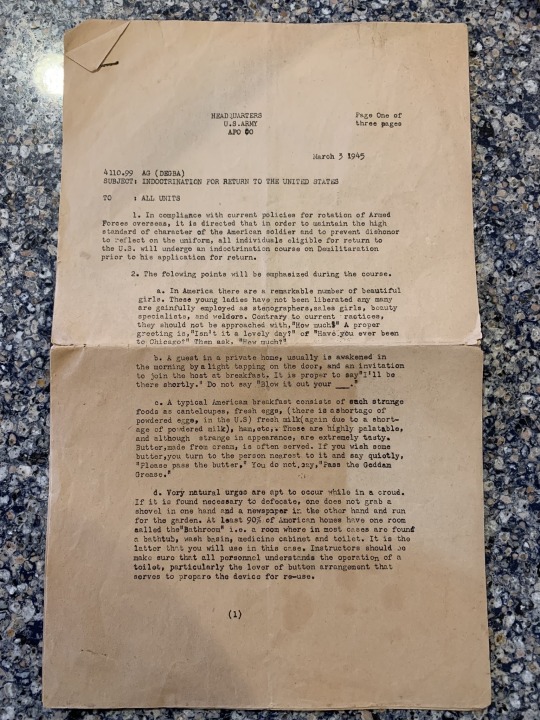
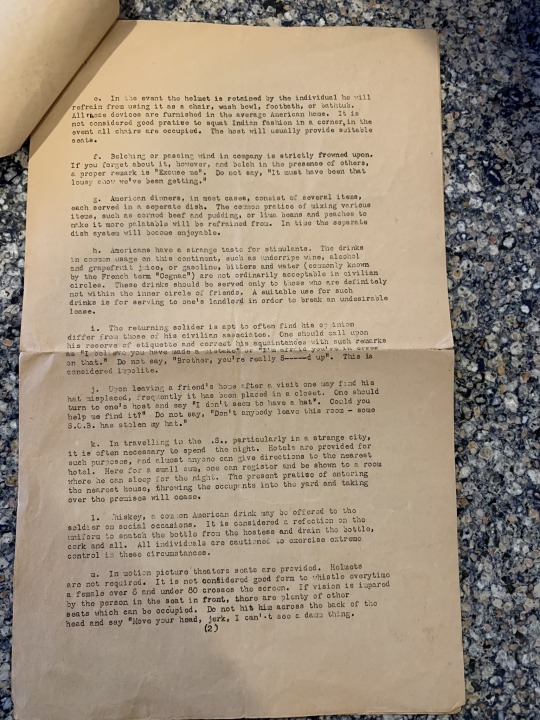
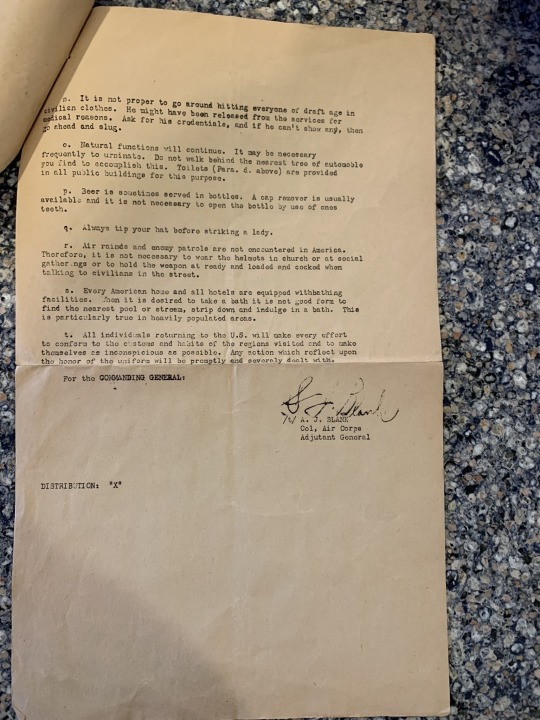
My father served in Burma, which is now Myanmar. I think he also did some time in Taiwan. When he was discharged, he was 21 years old. I think he served several years. A kid from Brooklyn. My father’s native habitat was the New York suburbs; I cannot imagine him in tropical Asia.
I found this document when I was a teenager in the 1970s, investigating the garage of our house on Long Island. I found it again while going through my Dad‘s papers after he passed in 2004. After that, the document disappeared into the clutter of my home office for nearly 20 years until I was decluttering this week, and the papers turned up again.
66 notes
·
View notes
Note
Harry understands politics better than the majority of his fans. There will be one teocratic Islamic republic of Palestine. All Palestinians will be liberated. All Palestinian lands. As long as Iran exists there will never be Two States one of which is an Occupier of Palestinian lands. Why can't you understand that? Arafat was KGB. Soviet Union aka Russia together with Iran and China will finish what Soviet Union started and erase Israel. Hezbollah, Islamic Jihad, Islamic Revolutionary Guard Corps, the Axis of Resistance will liberate all Palestinians. Palestine with Jews living in Palestine. Do you understand why Russia gave that Ultimatum to US and NATO in December 2021? It is a win-win for the Moscow-Tehran-Beijing Axis. Why do you think Putin is so happy after all those recent high-level meetings with Iran, Hamas in Moscow and China? When they win as US/NATO will capitulate in Ukraine/Europe, in the Middle East, Central Asia, South China Sea/Taiwan, having already lost Africa, Latam. BRICS will dethrone the dollar and thus democracies. That is new world order that Putin was talking about a few days ago, that will be the 21st century under dictatorships. China plans for 100 years. US/NATO/EU already lost. Democracies already lost. Netherlands is only another domino falling. It is work camps next. Some rainbow coloured.
New copy pasta just dropped 🤟
18 notes
·
View notes
Note
Interesting debate. Tankies are gonna tank, but Tiara made some odd claims for someone with their knowledge. Do you agree with Tiara's claim that the PRC is "the most powerful right-wing government on the planet"? Tiara also agreed with the tankie about cutting excess military spending. If one believes America should challenge Chinese and Russian imperialism, doesn't that call for an increase in military spending?
Pre-emptively tagging @opinions-about-tiaras, because unlike that tankie, I don't hide in the comments.
When I mention that the left-right spectrum is overly binary and limiting, this is precisely what I mean. China's place on this spectrum depends entirely on how you choose to define it. For some, left and right is seen as left pursuing social equality and egalitarianism while the right promotes a social hierarchy. In that sense, China's heavily unequal, hierarchal, ethnostate-focused politics, with a foreign policy dedicated to turning Southeast Asia into client-states would place that firmly on the right. For others, left and right is seen as the degree by which the state intervenes and controls in the economy, and China's economic policy would place it on the left. For my take, I don't really use the left-right spectrum save in specific contexts, so I can't really say that I agree or disagree with that statement.
One thing I will disagree with him on is calling China "capitalist." It's a common refrain among China-critical progressives to call China capitalist, but for my take, China appears to be very clearly cleaving to the old corporatist model that was common to the fascist states of earlier eras. It's not like having ultra-wealthy members of society is limited to capitalist countries alone - the elites of the Soviet Union were quite wealthy (and in the 1950's, income inequality was greater in the Soviet Union than the United States). But corporatism these days is largely a forgotten economic discipline, barely of interest to anyone who doesn't study the early 20th century and the actual economics of fascism, so I don't blame anyone for not knowing that.
Similarly, cutting military spending is a common policy goal among the left-liberal movement, so that's very much on-brand for a self-described "left-liberal." While I personally don't agree that we should cut military spending (although I think we should spend it in a wiser fashion), it's not exactly abnormal to think that - it's just an expression of where he believes that the limited resources should be allocated and in what proportions. There's plenty of ways to challenge Chinese and Russian imperialism without increasing the military budget. In fact, I support many of these ways: partnering with allies (Biden's work in improving the South Korea-Japan relationship as an example), investment in countries that need infrastructure (this one in particular has a lot of added benefits, particularly when it comes to climate - yet another reason I'm critical of the current dialogue regarding climate), and asymmetric defense capabilities to enforce deterrence (like we're doing with Taiwan). Each of them have benefits and drawbacks and any President must effectively manage those risks, that's just part of the nature of being a head of state. OOT's choice in that regard is simply a matter of prioritization and budgeting accordingly, it's neither hypocritical nor foolish.
Thanks for the question, Anon.
SomethingLikeALawyer, Hand of the King
25 notes
·
View notes
Text
Beijing announced six exclusion zones encircling Taiwan to facilitate live-fire military drills from Thursday to Sunday, with some of the areas crossing into the island’s territorial waters. [...]
Separately, the People’s Liberation Army said exercises could start as soon as Tuesday, leaving open the possibility of military activities around Taiwan while Pelosi was visiting. The operations include “long-range live firing in the Taiwan Strait” and “regular-guided fire testing in the eastern waters” off Taiwan from Tuesday evening, the PLA said.[...]
During the military drills, “relevant ships and aircraft should not enter the above sea areas and airspaces during this period,” the official Xinhua News Agency said in a report late Tuesday, which gave coordinates for the exercises.

2 Aug 22
197 notes
·
View notes
Note
Harry understands politics better than the majority of his fans. There will be one teocratic Islamic republic of Palestine. All Palestinians will be liberated. All Palestinian lands. As long as Iran exists there will never be Two States one of which is an Occupier of Palestinian lands. Why can't you understand that? Arafat was KGB. Soviet Union aka Russia together with Iran and China will finish what Soviet Union started and erase Israel. Hezbollah, Islamic Jihad, Islamic Revolutionary Guard Corps, the Axis of Resistance will liberate all Palestinians. Palestine with Jews living in Palestine. Do you understand why Russia gave that Ultimatum to US and NATO in December 2021? It is a win-win for the Moscow-Tehran-Beijing Axis. Why do you think Putin is so happy after all those recent high-level meetings with Iran, Hamas in Moscow and China? When they win as US/NATO will capitulate in Ukraine/Europe, in the Middle East, Central Asia, South China Sea/Taiwan, having already lost Africa, Latam. BRICS will dethrone the dollar and thus democracies. That is new world order that Putin was talking about a few days ago, that will be the 21st century under dictatorships. China plans for 100 years. US/NATO/EU already lost. Democracies already lost. Netherlands is only another domino falling. It is work camps next. Some rainbow coloured.
who tf is harry

13 notes
·
View notes
Note
Harry understands politics better than the majority of his fans. There will be one teocratic Islamic republic of Palestine. All Palestinians will be liberated. All Palestinian lands. As long as Iran exists there will never be Two States one of which is an Occupier of Palestinian lands. Why can't you understand that? Arafat was KGB. Soviet Union aka Russia together with Iran and China will finish what Soviet Union started and erase Israel. Hezbollah, Islamic Jihad, Islamic Revolutionary Guard Corps, the Axis of Resistance will liberate all Palestinians. Palestine with Jews living in Palestine. Do you understand why Russia gave that Ultimatum to US and NATO in December 2021? It is a win-win for the Moscow-Tehran-Beijing Axis. Why do you think Putin is so happy after all those recent high-level meetings with Iran, Hamas in Moscow and China? When they win as US/NATO will capitulate in Ukraine/Europe, in the Middle East, Central Asia, South China Sea/Taiwan, having already lost Africa, Latam. BRICS will dethrone the dollar and thus democracies. That is new world order that Putin was talking about a few days ago, that will be the 21st century under dictatorships. China plans for 100 years. US/NATO/EU already lost. Democracies already lost. Netherlands is only another domino falling. It is work camps next. Some rainbow coloured.
I think you sent this to the wrong person brother
9 notes
·
View notes
Note
Harry understands politics better than the majority of his fans. There will be one teocratic Islamic republic of Palestine. All Palestinians will be liberated. All Palestinian lands. As long as Iran exists there will never be Two States one of which is an Occupier of Palestinian lands. Why can't you understand that? Arafat was KGB. Soviet Union aka Russia together with Iran and China will finish what Soviet Union started and erase Israel. Hezbollah, Islamic Jihad, Islamic Revolutionary Guard Corps, the Axis of Resistance will liberate all Palestinians. Palestine with Jews living in Palestine. Do you understand why Russia gave that Ultimatum to US and NATO in December 2021? It is a win-win for the Moscow-Tehran-Beijing Axis. Why do you think Putin is so happy after all those recent high-level meetings with Iran, Hamas in Moscow and China? When they win as US/NATO will capitulate in Ukraine/Europe, in the Middle East, Central Asia, South China Sea/Taiwan, having already lost Africa, Latam. BRICS will dethrone the dollar and thus democracies. That is new world order that Putin was talking about a few days ago, that will be the 21st century under dictatorships. China plans for 100 years. US/NATO/EU already lost. Democracies already lost. Netherlands is only another domino falling. It is work camps next. Some rainbow coloured.
You must’ve sent this to the wrong person.
6 notes
·
View notes
Text

China offered its Y-20 transport plane to Nigeria
The air transport plane was placed on the international market in November, when it was shown to the head of Nigeria's defense.
Fernando Valduga By Fernando Valduga 01/13/2024 - 19:00 in Military
China is trying to sell its Y-20 Kunpeng transport plane to foreign buyers, with its manufacturer expanding production capacity in preparation, according to media reports.
The strategic military transport aircraft was placed on the international market in November, when the Y-20BE model was shown to Nigeria's Defense Minister Mohammed Badaru Abubakar in Beijing, the military magazine Ordnance Industry Science Technology reported last week.
The heavy transport plane, nicknamed the 'chubby girl' (chubby girl) for its large fuselage, is comparable to the Soviet Ilyushin Il-76 and the American Boeing C-17.
According to the report, it will be an opportunity for China to “establish deeper strategic relations and cooperation with countries as soon as they have the Y-20”.
Although Nigeria currently depends on the C-130 Hercules as its main tactical air transport aircraft, military experts say the Y-20E would provide the country with genuine strategic air transport capabilities.

The aircraft manufacturer, XAIC, operates assembly lines for mass production, according to the Chinese state broadcaster.
Its manufacturer, the state-owned Xian Aircraft Industrial Corporation (XAIC), has been operating assembly lines for mass production to increase efficiency and expand capacity, the state broadcaster CCTV reported in November.
Instead of mounting the aircraft on a fixed workstation, its parts are moved along a "pulse line" as the work steps are completed - similar to the way cars are produced. These assembly lines are used to build some of the most advanced aircraft in the world, including the Lockheed Martin F-35 and the Boeing 787.
More than 90 percent of the parts of the Y-20 are manufactured by a digitized system, according to the CCTV report, which showed images from the XAIC factory of robotic arms, remotely controlled maneuvers and laser-assisted high-precision assembly work.
The broadcaster's report said that the production capacity of the plant could meet the demand of both the Chinese air force and international customers.
"The production speed of the Y-20 is the fastest in the world in this type," he said.

The People's Liberation Army Air Force (PLAAF) has received almost 100 planes so far, half of them in the last two years.
The plane, which is 47 meters long and 50 meters wide, has become the flagship of the People's Liberation Army since it entered service in 2016. It can transport up to 66 tons.
XAIC has delivered almost 100 planes to the PLA Air Force so far - about half of them in the last two years. It also changed from Russian-made Soloviev D-30KP-2 engines to the most powerful Chinese-made Shenyang WS-20 turbofan engines.
Variants were also developed, the Y-20U tank plane and the Y-20AEW airborne alert and early control aircraft.
Tags: Military AviationChinaNAF - Nigerian Air Force/Nigerian Air ForceXian Y-20
Sharing
tweet
Fernando Valduga
Fernando Valduga
Aviation photographer and pilot since 1992, he has participated in several events and air operations, such as Cruzex, AirVenture, Dayton Airshow and FIDAE. He has works published in specialized aviation magazines in Brazil and abroad. He uses Canon equipment during his photographic work in the world of aviation.
Related news
MILITARY
J-10C jets from Pakistan and Eurofighter from Qatar face each other in joint exercise
13/01/2024 - 17:58
MILITARY
Taiwan wants to develop a new basic training plane
13/01/2024 - 16:41
This graph shows an E-4B Nightwatch aircraft in a hangar being digitized and rendered digitally to better illustrate the multi-day effort by the company Mass Virtual to build a three-dimensional virtual representation of the Boeing 747 for training purposes.
MILITARY
With "final judgment planes" in high demand, USAF resorts to Virtual Reality training in digital replica
13/01/2024 - 15:29
MILITARY
India reveals first national MALE drone called Drishti 10 Starliner
13/01/2024 - 14:17
MILITARY
VIDEO: Norway starts 2024 with the deployment of F-35 fighters in Iceland
13/01/2024 - 11:49
BRAZIL
Child with rare syndrome realizes the dream of meeting FAB planes
13/01/2024 - 11:40
7 notes
·
View notes
Note
Harry understands politics better than the majority of his fans. There will be one teocratic Islamic republic of Palestine. All Palestinians will be liberated. All Palestinian lands. As long as Iran exists there will never be Two States one of which is an Occupier of Palestinian lands. Why can't you understand that? Arafat was KGB. Soviet Union aka Russia together with Iran and China will finish what Soviet Union started and erase Israel. Hezbollah, Islamic Jihad, Islamic Revolutionary Guard Corps, the Axis of Resistance will liberate all Palestinians. Palestine with Jews living in Palestine. Do you understand why Russia gave that Ultimatum to US and NATO in December 2021? It is a win-win for the Moscow-Tehran-Beijing Axis. Why do you think Putin is so happy after all those recent high-level meetings with Iran, Hamas in Moscow and China? When they win as US/NATO will capitulate in Ukraine/Europe, in the Middle East, Central Asia, South China Sea/Taiwan, having already lost Africa, Latam. BRICS will dethrone the dollar and thus democracies. That is new world order that Putin was talking about a few days ago, that will be the 21st century under dictatorships. China plans for 100 years. US/NATO/EU already lost. Democracies already lost. Netherlands is only another domino falling. It is work camps next. Some rainbow coloured.
huh??
5 notes
·
View notes
Text
If U.S. President Joe Biden wants to check the pulse of the arsenal of democracy, all he has to do is look at Bill LaPlante’s wall in the Pentagon. The U.S. Defense Department industrial chief’s office is covered with production charts for every weapon that the United States is building to fend off a potential war with China while helping countries such as Ukraine and Israel fend for themselves in wars of their own.
It’s like an electrocardiogram of the U.S. defense industry: There’s a line going up to count the number of units moved and a line going sideways for the time that it took to move them. There are production rates for the Patriot missiles that the United States has sent to the Middle East to provide backup for Israel, the sea-launched Standard Missile-6 that the United States has deployed to the Indo-Pacific to potentially bloody China’s nose if it launches an assault on Taiwan, and the guided multiple launch rockets—known as GMLRs—that helped the Ukrainians liberate Kherson and the areas around Kharkiv in a one-two punch to the Russian army in 2022.
“It’s a whole stair step,” LaPlante told a small gaggle of reporters at the Reagan National Defense Forum in California in early December 2023. The chart, he said, “keeps going and going.”
And even though business is booming, Defense Department officials are facing a problem from hell. How can the Pentagon mobilize the U.S. defense industry to respond to not just one conflict or two, but potentially three wars? Foreign Policy talked to a dozen defense ministers, officials, and experts across the NATO alliance. They described an almost Sisyphean task to rebuild the trans-Atlantic—and trans-Pacific—defense industrial base to fight three wars not during a world war, but when much of the Western world is at peace.
“We are moving from a just-in-time, just-enough economy model to a peak demand model,” said Dutch Adm. Rob Bauer, the chairman of NATO’s military committee, in an interview in his office at the alliance’s Brussels headquarters in October. Much like the manner in which the Western world had to convert factories at dizzying speed to produce protective medical equipment during the COVID-19 pandemic, Western leaders need to “make sure everybody understands the sense of urgency of where we are,” Bauer said.
Officials are still trying to figure out what the right number is for every weapon on LaPlante’s chart. What makes planning especially difficult is the friction of war. Nobody expected the war in Ukraine to suck up thousands of artillery shells every single day, year after year. Few thought that Israel’s war against Hamas in the Gaza Strip would exhaust precision-guided munitions in a couple of months. If the United States were in a war with China over the Taiwan Strait, it could run out of long-range precision munitions within a week, according to one study.
There was a time when the United States could turn plowshares into swords; in the Second World War, the United States built more of pretty much everything than any other combatant, from tanks to planes to ships to landing craft. Then-President Franklin D. Roosevelt called it the “arsenal of democracy” because it was. In five years, U.S. factories built 141 aircraft carriers, 88,410 self-propelled guns and tanks, and 257,000 artillery guns.
Now, Washington is trying to get back in business after three decades of post-Cold War belt-tightening that saw companies merge and production lines slow down. LaPlante said that the Pentagon has built a facility in Texas that has the capacity to surge 155 mm artillery shells as needed. Boeing is growing its capacity to build sensors for Patriot missiles at its Huntsville, Alabama, facility by nearly a third.
In Europe, Bulgaria and the Czech Republic are becoming major producers of ammunition. Germany is buying hundreds of millions of dollars worth of artillery shells while Rheinmetall sets up shop inside Ukraine. Sweden, Denmark, and Norway have begun jointly procuring 155 mm barrels for Ukraine. And the Swedish manufacturer Saab—which no longer makes cars—is producing so many diesel-electric submarine hulls that it’s even looking at Southeast Asia as potential clients.
Building industrial muscle means that the Pentagon needs to rebuild long-atrophied bureaucratic muscle, too. LaPlante has deputized a so-called “joint production cell” within the Pentagon, comprising defense officials who are visiting production floors. It’s not just a question of getting scientists and dollars, but also of getting factories full of skilled welders, assemblers, and foremen.
“It’s dusting off a lot of skills that we’ve had in this country that we haven’t used in a while,” LaPlante said.
But there’s a bigger problem, too: It’s one thing to assemble shells and missiles, and another thing altogether to assemble higher-end gear such as the B-21 Raider stealth bomber, which runs at about $750 million per airplane, with a production line that snakes across three U.S. states. Building the aircraft is so complex that U.S. officials have compared it to the nearly four-decadeslong process of building the interstate highway system.
Some of the weapons still have to be funded. Congress has already agreed to fund SM-6 and GMLRS. Other projects, such as the Pentagon’s plan to get up to 100,000 rounds of 155 mm artillery produced by 2025, need Congress to pass the supplemental budget, LaPlante said. With Congress out for the holidays, that’s on hold until at least January. And across the Atlantic, the European Union has fallen far behind its target of producing 1 million artillery rounds per year to feed Ukraine’s voracious appetite for ammunition while replenishing NATO stockpiles.
But when LaPlante and other Pentagon officials go into meetings with industry and members of Congress to tout their plans, they face two big questions about the United States’ military-industrial buildup. Are they going to pull the plug, especially as Congress wavers on additional U.S. military aid to Ukraine, Taiwan, and Israel? And even if they’re for real, are their plans even enough?
When it comes to putting shells in barrels, since December 2022, the U.S. industrial base has doubled its output of 155 mm ammunition, growing it from 14,000 rounds per month to between 28,000 to 30,000, LaPlante said. U.S. Army officials hope to get to 60,000 rounds per month by September 2024, and to the magic number of 100,000 rounds per month by the end of 2025.
The Pentagon has put about $3 billion toward the ramp-up so far, the price of about four B-21 bombers, sprinkling contracts across five U.S. states and three countries.
The European Union is producing between 600,000 and 700,000 artillery shells per year, Estonian Defense Minister Hanno Pevkur told reporters in November, well short of the 27-nation bloc’s 1 million shell goal, which it hopes to reach next year. To support Ukraine and recapitalize its own stockpiles, Europe will have to reach about 3 million rounds per year in the next 10 years, Pevkur said.
But Ukraine’s appetite for artillery ammo is voracious, about 6,000 shells per day at the peak of fighting this year— and the shortage of U.S. military aid is already causing troops to hold their fire on the front lines. The pain of growing the arsenal is hard, Western officials concede, but the pain of losing the war would be far worse.
“There is no option but to rise to the occasion in this regard,” Swedish Defense Minister Pal Jonson said in an interview with Foreign Policy.
And when it comes to so-called smart bombs—weapons with GPS guidance kits built in—the situation is even more dire. Despite the United States allowing Israel to raid precision munition stockpiles in the region, more than half of the air-to-ground weapons fired into the Gaza Strip since October have been unguided “dumb bombs,” according to U.S. intelligence reports.
All of that is without accounting for the weapons needed to fight the next war: ships, submarines, sea-based missiles, and coastal defenses. China has done everything short of invading Taiwan, though it has vowed to do so at some point soon. In a naval fight, shipyards count as much or more than hulls in the water, and there the United States is beached. Even when it comes to what the United States is really good at—building and operating high-end nuclear submarines—they are artisanal affairs. The rest of the U.S. Navy is shrinking while China’s is growing.
“We’re spending 3.3 percent of GDP on national defense and you’re building a paltry 1.2 subs” a year, said U.S. Sen. Roger Wicker, the top Republican on the Senate Armed Services Committee. “I don’t think that is making [Chinese President] Xi Jinping quake in his boots.”
The United States has to outsource its defense procurement, as do most countries—which, in the long hangover of the post-Cold War era, means a very rude awakening. Some NATO countries, such as Poland, which keeps more of its defense industry in state hands than most other member countries, can expand production lines on the back of public spending.
The United States can only prod and pray—the Pentagon’s own soon-to-be-released industrial strategy indicates that defense companies wouldn’t be able to respond fast enough for the U.S. military to fight a modern war.
For instance: The biggest bottleneck in sending GMLRS and 155 mm ammo to Ukraine is the lack of rocket motors, said Heidi Shyu, who oversees the Pentagon’s technology strategy. So the U.S. Defense Department has initiated a parallel effort to make sure that rocket motors get built, too. But it’s a slog.
“Ramping up production is not like a light switch, where you can flip the switch and bang, you can tenfold your production,” Shyu said. “You just can’t do that. Every country that has the ability to ramp up production is in the process of ramping up.”
Further down the food chain, the U.S. Defense Department is running into problems; there aren’t enough testing beds for new weapons systems, for example. There aren’t enough good programmers to write good code. And there aren’t enough little things that go boom up and down the U.S. supply chain to feed all of the Ukrainian gun barrels, let alone those of other allies.
Europe is feeling the same crunch.
“What are the smaller obstacles? First, fuses. Second, gunpowder. Third, shells.” said Pevkur, Estonia’s defense minister. “You have to be able to solve all of these small details in order to be ready to produce more rounds.”
U.S. partners are getting creative, given the lack of backup. Ukrainian President Volodymyr Zelensky has announced a 1-million-drone target to build one-hit kamikazes that can strike Russian troops deep behind their lines. They’re conducting do-it-yourself air defense with obsolete Soviet-era munitions. And Taiwan, still stuck in a billion-dollar backlog of U.S. weapons sales, has started doing F-16 maintenance on its own.
But none of that is going to restore the arsenal of democracy, whose shelves—already bereft, if not barren—aren’t getting restocked like they used to.
“There is an end to every stockpile,” Bauer said. “There’s an end to it.”
7 notes
·
View notes
Note
Harry understands politics better than the majority of his fans. There will be one teocratic Islamic republic of Palestine. All Palestinians will be liberated. All Palestinian lands. As long as Iran exists there will never be Two States one of which is an Occupier of Palestinian lands. Why can't you understand that? Arafat was KGB. Soviet Union aka Russia together with Iran and China will finish what Soviet Union started and erase Israel. Hezbollah, Islamic Jihad, Islamic Revolutionary Guard Corps, the Axis of Resistance will liberate all Palestinians. Palestine with Jews living in Palestine. Do you understand why Russia gave that Ultimatum to US and NATO in December 2021? It is a win-win for the Moscow-Tehran-Beijing Axis. Why do you think Putin is so happy after all those recent high-level meetings with Iran, Hamas in Moscow and China? When they win as US/NATO will capitulate in Ukraine/Europe, in the Middle East, Central Asia, South China Sea/Taiwan, having already lost Africa, Latam. BRICS will dethrone the dollar and thus democracies. That is new world order that Putin was talking about a few days ago, that will be the 21st century under dictatorships. China plans for 100 years. US/NATO/EU already lost. Democracies already lost. Netherlands is only another domino falling. It is work camps next. Some rainbow coloured.
is this about harry styles
5 notes
·
View notes
Note
Harry understands politics better than the majority of his fans. There will be one teocratic Islamic republic of Palestine. All Palestinians will be liberated. All Palestinian lands. As long as Iran exists there will never be Two States one of which is an Occupier of Palestinian lands. Why can't you understand that? Arafat was KGB. Soviet Union aka Russia together with Iran and China will finish what Soviet Union started and erase Israel. Hezbollah, Islamic Jihad, Islamic Revolutionary Guard Corps, the Axis of Resistance will liberate all Palestinians. Palestine with Jews living in Palestine. Do you understand why Russia gave that Ultimatum to US and NATO in December 2021? It is a win-win for the Moscow-Tehran-Beijing Axis. Why do you think Putin is so happy after all those recent high-level meetings with Iran, Hamas in Moscow and China? When they win as US/NATO will capitulate in Ukraine/Europe, in the Middle East, Central Asia, South China Sea/Taiwan, having already lost Africa, Latam. BRICS will dethrone the dollar and thus democracies. That is new world order that Putin was talking about a few days ago, that will be the 21st century under dictatorships. China plans for 100 years. US/NATO/EU already lost. Democracies already lost. Netherlands is only another domino falling. It is work camps next. Some rainbow coloured.
???????????
6 notes
·
View notes